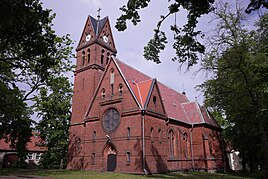Straach
|
Straach
Coordinates: 51 ° 57 ′ 16 " N , 12 ° 35 ′ 45" E
|
|
|---|---|
| Height : | 125 m above sea level NHN |
| Area : | 22.8 km² |
| Residents : | 753 (December 31, 2016) |
| Population density : | 33 inhabitants / km² |
| Incorporation : | January 1, 2010 |
| Postal code : | 06889 |
| Area code : | 034929 |
|
Straach Church
|
|
Straach is a village in Lutherstadt Wittenberg in Saxony-Anhalt . It includes the districts of Straach, Berkau and Grabo.
geography
Straach is about 10 kilometers north of the city center in the Fläming Nature Park . The Rischebach, which rises not far from the village, flows through the village. Only a small part of the stream has been embedded so far, so that the natural course of the stream has largely been preserved.
history
Straach was first mentioned in a document in 1390 and got its name from Old Sorbian (Straach = shrub). It was an official village and belonged to the " Old Office Wittenberg ".
For centuries, the residents were primarily engaged in agriculture and livestock. As a result of the rich clay deposits around Straach, the first pottery was built around 1820 , such as a bottle pottery , a tile and crockery pottery and a brickworks .
Archaeological excavations and reports from 2003 showed that the place was already settled around 200 AD. Using the existing clay, ceramics were already being produced as a commodity at that time. Remains of kilns, ceramic shards and building remains (workshop) were found and registered in the northern part of the village during archaeological excavations.
After the increasing industrial production of glass bottles, mainly household crockery was produced, which can still be admired in many households today and which often has antiquarian value. In addition, there were many craftsmen who practiced their trade in Straach.
Straach was conveniently located in terms of transport. The village touched the old trade and post route that led from Wittenberg via Rabenstein to Belzig . The old post road from Treuenbrietzen to Coswig also led via Straach. At that time the stagecoaches drove there between Berlin and Halle . Thus Straach was an important crossroads for post and trade. Around 1840 the population had risen to around 300.
In 1904 a new dairy building was inaugurated. The huge factory chimney was visible far beyond Straach until 2008 and shaped the townscape.
In 1910 the Straacher Gymnastics Club was founded, which for many years had an exceptional position in the region and helped shape social life in the village.
In 1911 the Straacher celebrated the commissioning of the new railway line from Wittenberg to Straach.
At the end of 1945, the chronicle of the population says that there were 451 locals and 551 resettlers in Straach. Parts of the land were expropriated and redistributed as part of the land reform .
The public sector maintains a kindergarten in Straach. The local clubs use the gymnasium and multi-purpose hall both for sporting activities and for holding dance events, such as the traditional Carnival, the New Year's Eve ball or village festivals.
There is a doctor's station, dentist and pharmacy, physiotherapy, orthopedic technology in Straach . Hairdressers, beauty salons, restaurants, agricultural goods shops, shoe sales, bakery and grocery stores are just as much a part of it as electricians, heating engineers and hardware dealers . The local trade is represented by three large local companies: the Straacher Metallverarbeitung GmbH, the Straacher Produktions- und Handels GmbH and the Agrargenossenschaft Straach.
The sporting and cultural life is shaped by the local clubs: the cultural and sports club, the Rote Teufel sports club, the local history club, the fire brigade club and the hiking club. The modern volunteer fire brigade is also particularly noteworthy .
After 1990, the communal administration of the then still independent municipality took place first in the administrative community of South Fleming , from 2005 in the administrative community of Elbaue-Fläming .
On January 1, 2010 the community of Straach with its districts Berkau and Grabo was incorporated into Lutherstadt Wittenberg. The local mayor is Klaus Eckert.
Attractions
The red brick church in the center of the village in the late Romanesque style is somewhat atypical for Fläming . Fläming is generally known for its stone churches, but this "red one" is no less a sight. The church tower was once a little higher, but for a few years there has been a church tower clock again, which can be heard and seen from afar with a bright sound and a white dial.
The first church in Straach (a field stone church typical of Fleming ) stood in the village cemetery. The “red” new building of the church took place at the end of the 19th century (inauguration on May 14, 1886). The church was demolished and rebuilt because its predecessor was too small and because it was damaged in times of war. The first person to be baptized in the newly built church was Gustav Lehmann.
Economy and Infrastructure
traffic
In Straach, the state roads L 123 cross between Coswig and Kropstädt and L 124 between the state border with Brandenburg at Groß Marzehns and Lutherstadt Wittenberg.
The junction Klein Marzehns the motorway A9 Berlin-Munich km to the northwest. 9 To Bundesstrasse 2 , which connects Berlin and Lutherstadt Wittenberg, in Kropstädt it is about 14 km to the east.
The place was the end of the Lutherstadt Wittenberg – Straach railway line , which opened in 1911 and on which passenger traffic was discontinued in 1959.
